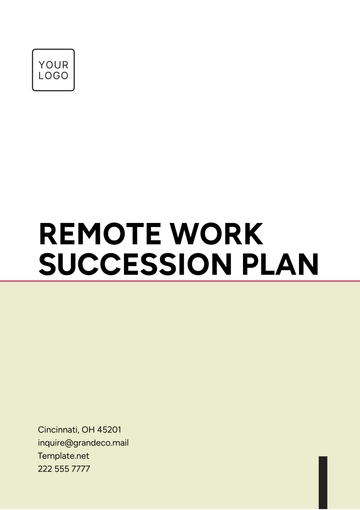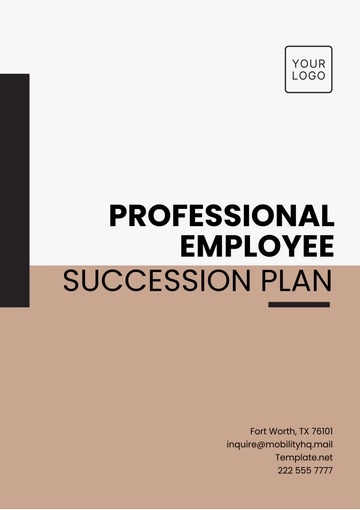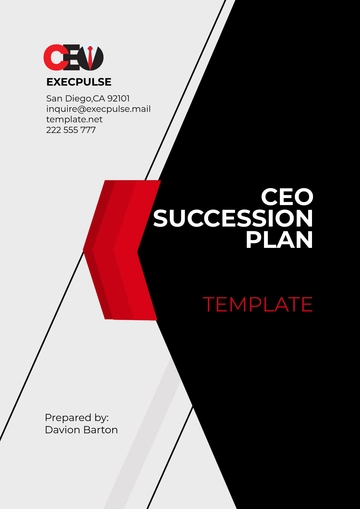Free CEO Succession Plan

I. Introduction
A. Purpose of the Succession Plan
The purpose of this CEO Succession Plan is to ensure a seamless leadership transition at [Your Company Name] in the event of the current CEO’s departure, retirement, or incapacity. It is designed to protect the company's stability, strategic direction, and long-term goals during any leadership changes. This plan outlines the procedures and criteria for selecting and transitioning a new CEO to maintain continuity in leadership.
B. Objectives and Goals of the Succession Process
The main objectives of the succession process include identifying potential candidates within the organization and externally, ensuring a robust leadership pipeline, and preparing for both predictable and unpredictable transitions. The goal is to select a successor who embodies the company's values and strategic vision for the future. Additionally, the process aims to maintain employee confidence, preserve operational continuity, and uphold stakeholder trust during the transition.
C. Overview of the Plan Structure
This document is structured to cover governance roles, the identification and evaluation process for successors, leadership development, and emergency succession protocols. It includes timelines for transition, the communication plan, and post-transition support for the new CEO. A review process ensures the plan is up to date and remains effective in light of evolving organizational and external circumstances.
II. Governance and Oversight
A. Role of the Board of Directors
The Board of Directors holds the primary responsibility for overseeing the CEO succession process, ensuring that leadership changes are handled smoothly and with minimal disruption. The board will ensure that all succession activities align with the company’s strategic goals and values. The Board, as the final decision-making body, will approve the selected candidate after a thorough evaluation process.
B. Role of the Nominating or Governance Committee
The Nominating or Governance Committee will oversee the development and execution of the succession plan. This committee will work closely with the Board to assess leadership needs, identify suitable candidates, and recommend the final selection. It will also manage ongoing leadership development initiatives to ensure the future availability of qualified candidates.
C. Role of the CEO
The current CEO, [Current CEO's Name], will play an advisory role in the succession process, mentoring potential successors and providing feedback on leadership qualities essential for the company’s future. The CEO will help facilitate leadership exposure for internal candidates and ensure the alignment of the succession plan with the company’s mission. Although the CEO is not the final decision-maker, their involvement is crucial in ensuring that the right skills and values are passed on.
III. Identification and Evaluation of Potential Successors
A. Criteria for Selecting a New CEO
The new CEO must demonstrate strong leadership skills, a deep understanding of [Your Company Name]'s industry, and the ability to drive innovation while maintaining the company’s core values. They should also possess excellent strategic vision, proven decision-making abilities, and a commitment to fostering a positive corporate culture. The candidate must be able to navigate the challenges of the global marketplace and lead [Your Company Name] to continued success in the coming decades.
B. Internal Candidates
Internal candidates will be evaluated based on their experience, leadership track record, and readiness to take on the CEO role. Key internal candidates include [Potential Internal Candidate 1], [Potential Internal Candidate 2], and [Potential Internal Candidate 3], all of whom have demonstrated strong leadership capabilities. Leadership development programs, executive coaching, and mentoring initiatives will continue to ensure these candidates are prepared for a smooth transition.
C. External Candidates
Should the Board decide to seek an external candidate, the search will focus on individuals with significant experience in leading large, complex organizations, particularly those with expertise in technology-driven industries. We will engage an executive search firm with a proven track record to identify potential candidates who bring fresh perspectives and strategic expertise. The process will include a thorough evaluation of candidates’ cultural fit with the company and alignment with its long-term goals.
IV. Development of Potential Successors
A. Leadership Development Programs
[Your Company Name] offers extensive leadership development programs designed to nurture future executives, including cross-functional training and exposure to key areas of the business. The company provides mentorship from senior leadership, including the current CEO, to prepare high-potential candidates for top leadership positions. These programs are regularly reviewed to ensure that candidates develop the necessary skills for long-term success in leadership roles.
B. Regular Performance Reviews
Potential successors undergo quarterly performance reviews to assess their progress toward the CEO role, with specific focus on leadership competencies, decision-making, and business results. Feedback from the Board and senior leadership is incorporated into personalized development plans, ensuring that candidates receive targeted support. These reviews ensure that each successor is prepared for the challenges of the CEO role and can address any gaps in their readiness.
C. Emergency or Interim Leadership Development
In addition to regular leadership development, we maintain an emergency succession protocol for sudden leadership transitions. Interim leadership candidates, such as [Potential Interim Candidate 1], will be prepared to step into the CEO role in case of unexpected departures. This ensures that the company can continue its operations smoothly without interruption and that the transition to a permanent CEO is well-supported.
V. Succession Timing and Process
A. Predictable Succession (Retirement, Planned Transitions)
The planned retirement of the current CEO in 2052 is anticipated to follow a structured transition timeline that includes a public announcement in early 2052. Succession planning activities will ramp up in 2051, with final candidate selection occurring six months prior to the CEO’s retirement. A thorough handover period will begin six months before the CEO steps down, with active collaboration between the outgoing and incoming CEO.
B. Unpredictable Succession (Sudden Departure)
In the event of an unexpected CEO departure, the company will immediately implement its emergency succession plan, appointing an interim CEO from within the senior leadership team. The Board will initiate the formal search for a permanent successor, aiming for swift but careful evaluation of both internal and external candidates. Communication to employees, investors, and stakeholders will be handled promptly to maintain trust and transparency.
VI. Selection and Appointment Process
A. Evaluation and Selection Criteria
Candidates for CEO will be evaluated based on leadership capabilities, industry experience, vision for the company’s future, and alignment with [Your Company Name]’s values. The selection process will include detailed interviews with Board members, executive leadership, and external stakeholders to assess the candidate’s strategic thinking and cultural fit. An external executive search firm may be engaged for broader perspective and to provide candidate recommendations.
B. Board’s Role in Appointing the New CEO
The Board of Directors will lead the final decision-making process, reviewing candidate qualifications and aligning their leadership styles with the company’s strategic direction. Once a candidate is selected, the Board will formally appoint them as the new CEO, with an official announcement made to all stakeholders. The outgoing CEO will support the new CEO through a handover period to ensure continuity and stability.
C. Transition Timeline
A structured transition timeline will include a detailed plan for the outgoing CEO’s retirement, with milestone meetings to ensure alignment between the two leaders. The handover will include key meetings with internal teams, stakeholders, and strategic partners. The transition period will be designed to take no longer than six months, allowing the new CEO to assume full responsibility while retaining necessary guidance from the outgoing leader.
VII. Communication Plan
A. Internal Communication
Internal communication regarding the CEO transition will begin with an announcement to employees from the current CEO, followed by individual meetings with key leadership teams. The goal is to ensure clarity and confidence in the new CEO's ability to lead the company. Regular updates will be provided to employees throughout the transition process, emphasizing the continuity of company values and strategic direction.
B. External Communication
The company will communicate the CEO transition to investors, stakeholders, and the media through a press release, followed by individual briefings with key external partners. Communication will focus on the strategic vision of the new CEO and the company's commitment to long-term growth. Ongoing media outreach will reinforce the stability of the company and the capabilities of the new leadership.
VIII. Monitoring and Ongoing Review
A. Regular Review of the Succession Plan
The CEO Succession Plan will be reviewed annually by the Board to ensure its relevance and effectiveness. Feedback from the outgoing CEO, current leadership, and external consultants will be incorporated into any necessary updates. The plan will also be adjusted in response to changes in the business environment or corporate strategy.
B. Evaluation of Succession Process
After each leadership transition, the succession process will be evaluated for its success in ensuring continuity, leadership effectiveness, and stakeholder confidence. Adjustments to the process will be made based on lessons learned, with a focus on improving future CEO transitions. A post-transition review will be conducted to assess the new CEO’s integration and the impact on company performance.
IX. Confidentiality and Legal Considerations
A. Confidentiality of Succession Planning
All succession-related discussions and candidate evaluations will remain confidential to protect the privacy of potential successors and ensure the integrity of the process. Board members and executives involved in the succession process will sign confidentiality agreements. Leaked information regarding the succession process may lead to reputational damage and will be addressed swiftly.
B. Legal Requirements and Compliance
The succession plan will comply with corporate governance standards, including applicable laws on executive compensation and contractual obligations. Legal counsel will review the plan to ensure all aspects adhere to relevant laws and regulations. Additionally, the plan will be aligned with [Your Company Name]’s bylaws and any applicable shareholder agreements.
X. Conclusion
A. Recap of Plan’s Importance to Long-Term Success
The CEO Succession Plan is vital to maintaining [Your Company Name]'s stability, vision, and operational efficiency during leadership transitions. A clear, thoughtful process ensures that the company remains agile, resilient, and ready to face future challenges. By preparing for both planned and unexpected leadership changes, the company is better positioned to thrive in the years to come.
B. Next Steps in Implementation
The Board will begin to implement the succession plan in 2051, with the final selection of candidates completed six months prior to the CEO’s retirement. A communication and leadership development strategy will be rolled out to ensure smooth transition preparation. Regular updates will be provided to stakeholders throughout the process.
C. Ongoing Commitment to Leadership Excellence
[Your Company Name] is committed to fostering exceptional leadership at every level of the organization. This succession plan ensures that we have the right leaders in place to continue driving our company’s success. The company will continue to invest in leadership development and succession planning as integral parts of our growth strategy.
- 100% Customizable, free editor
- Access 1 Million+ Templates, photo’s & graphics
- Download or share as a template
- Click and replace photos, graphics, text, backgrounds
- Resize, crop, AI write & more
- Access advanced editor
Utilize the CEO Succession Plan Template from Template.net to streamline your organization’s leadership transition process. This fully editable and customizable template allows you to tailor each section to fit your company’s needs. With the powerful AI Editor Tool, you can effortlessly modify the document, ensuring a seamless and efficient succession planning experience.
You may also like
- Finance Plan
- Construction Plan
- Sales Plan
- Development Plan
- Career Plan
- Budget Plan
- HR Plan
- Education Plan
- Transition Plan
- Work Plan
- Training Plan
- Communication Plan
- Operation Plan
- Health And Safety Plan
- Strategy Plan
- Professional Development Plan
- Advertising Plan
- Risk Management Plan
- Restaurant Plan
- School Plan
- Nursing Home Patient Care Plan
- Nursing Care Plan
- Plan Event
- Startup Plan
- Social Media Plan
- Staffing Plan
- Annual Plan
- Content Plan
- Payment Plan
- Implementation Plan
- Hotel Plan
- Workout Plan
- Accounting Plan
- Campaign Plan
- Essay Plan
- 30 60 90 Day Plan
- Research Plan
- Recruitment Plan
- 90 Day Plan
- Quarterly Plan
- Emergency Plan
- 5 Year Plan
- Gym Plan
- Personal Plan
- IT and Software Plan
- Treatment Plan
- Real Estate Plan
- Law Firm Plan
- Healthcare Plan
- Improvement Plan
- Media Plan
- 5 Year Business Plan
- Learning Plan
- Marketing Campaign Plan
- Travel Agency Plan
- Cleaning Services Plan
- Interior Design Plan
- Performance Plan
- PR Plan
- Birth Plan
- Life Plan
- SEO Plan
- Disaster Recovery Plan
- Continuity Plan
- Launch Plan
- Legal Plan
- Behavior Plan
- Performance Improvement Plan
- Salon Plan
- Security Plan
- Security Management Plan
- Employee Development Plan
- Quality Plan
- Service Improvement Plan
- Growth Plan
- Incident Response Plan
- Basketball Plan
- Emergency Action Plan
- Product Launch Plan
- Spa Plan
- Employee Training Plan
- Data Analysis Plan
- Employee Action Plan
- Territory Plan
- Audit Plan
- Classroom Plan
- Activity Plan
- Parenting Plan
- Care Plan
- Project Execution Plan
- Exercise Plan
- Internship Plan
- Software Development Plan
- Continuous Improvement Plan
- Leave Plan
- 90 Day Sales Plan
- Advertising Agency Plan
- Employee Transition Plan
- Smart Action Plan
- Workplace Safety Plan
- Behavior Change Plan
- Contingency Plan
- Continuity of Operations Plan
- Health Plan
- Quality Control Plan
- Self Plan
- Sports Development Plan
- Change Management Plan
- Ecommerce Plan
- Personal Financial Plan
- Process Improvement Plan
- 30-60-90 Day Sales Plan
- Crisis Management Plan
- Engagement Plan
- Execution Plan
- Pandemic Plan
- Quality Assurance Plan
- Service Continuity Plan
- Agile Project Plan
- Fundraising Plan
- Job Transition Plan
- Asset Maintenance Plan
- Maintenance Plan
- Software Test Plan
- Staff Training and Development Plan
- 3 Year Plan
- Brand Activation Plan
- Release Plan
- Resource Plan
- Risk Mitigation Plan
- Teacher Plan
- 30 60 90 Day Plan for New Manager
- Food Safety Plan
- Food Truck Plan
- Hiring Plan
- Quality Management Plan
- Wellness Plan
- Behavior Intervention Plan
- Bonus Plan
- Investment Plan
- Maternity Leave Plan
- Pandemic Response Plan
- Succession Planning
- Coaching Plan
- Configuration Management Plan
- Remote Work Plan
- Self Care Plan
- Teaching Plan
- 100-Day Plan
- HACCP Plan
- Student Plan
- Sustainability Plan
- 30 60 90 Day Plan for Interview
- Access Plan
- Site Specific Safety Plan























